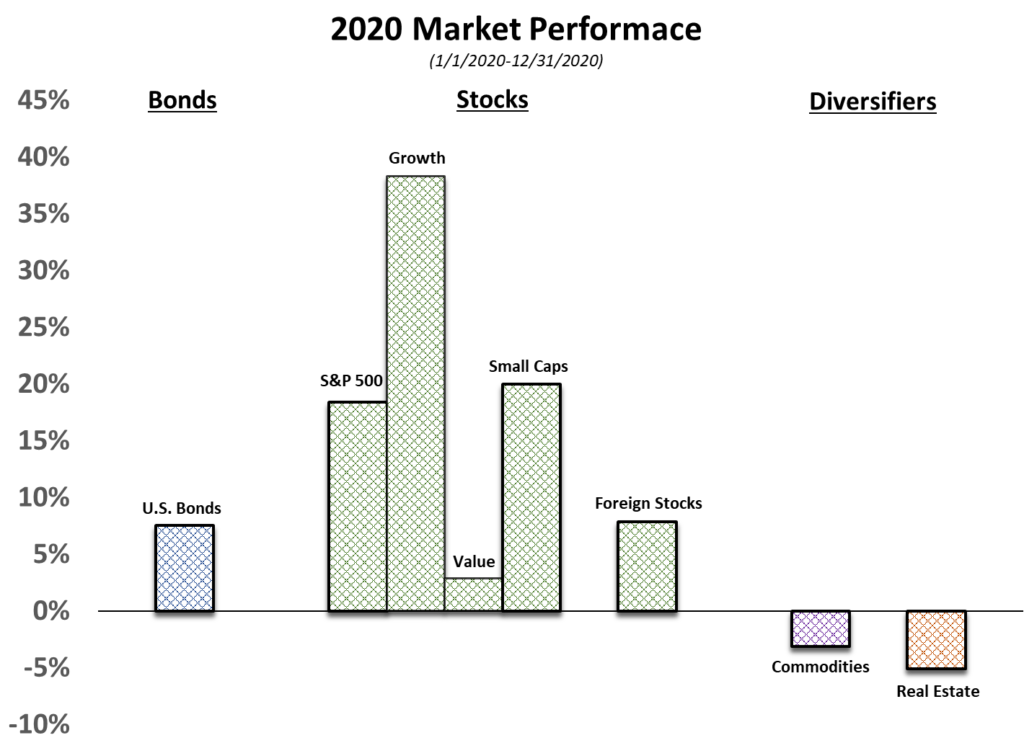2020 Annual Market Recap
By Clint EdgingtonPosted on January 5th, 2021
2020 will always be remembered as a tumultuous year. When we write out the events that occurred, it’s hard to flesh that against the blistering 18.4% the U.S. stock market [1] returned this year.
The pandemic gave us our fastest bear market and the fastest respondent bull market, all in the matter of about a month.
The market reaction to the pandemic response was even more unintuitive. While Main Street businesses that we interact with daily suffered, larger multinationals and companies that help with anything online profited. Interest rates fell, and asset prices rose.
It’s difficult to think about how the immense amount of money pumped into our economy by the monetary and fiscal stimulus works; that the money pumped in has to bubble back up somewhere. While savers in low risk investments or cash effectively finance this through lower valued future dollars and lower interest rates, stock investors generally gain. And they did. While real estate that passive investors invest in through REITS (mostly commercial) was hurt, homeowners saw their home values appreciate quickly due to low mortgage rates due to that monetary stimulus.

The above graph shows generally great returns – but 2020 can’t be reviewed in one static graphic; here’s a “blow by blow” that’ll help refresh our memories of this turbulent year.
November – November marked a turning point in the market due to good news on the vaccine front, with rotation away from areas that benefit from the Work From Home trend and the pandemic; and most areas of the market buoyed by lessening U.S. political uncertainty.
October – A curious month where teasing out “why” the market was doing what it was doing was difficult. Economic activity was generally positive for the month. The U.S. equity markets started off on a tear likely due to the upcoming presidential elections, hopes of further stimulus, and a plateau in COVID-19 case counts. The back half of the month shed those gains plus some, culminating in last week being the worst week since March.
September: The third quarter enjoyed broad economic optimism, but the markets tempered through September as COVID-19 cases rose and stimulus talks came to a halt.
August: A bit of reserved economic optimism shined through as case counts began to moderate, and news of vaccine developments and timelines generally became more encouraging.
July: July markets continued the general trend already present in equity markets. The COVID-19 pandemic continued to affect the economy, as the market looked toward the future. Growth stocks outpaced Value stocks, as some of the largest Growth stocks in the index (Amazon, Facebook, and to a lesser extent Apple) benefited from the Work From Home trend.
June: The markets quickly took into account optimistic news on new case counts, the vaccine front, and amazing amounts of fiscal and monetary stimulus, posting a huge bounceback from the previous quarter with the S&P’s return of 20%.
May: The month of May extended the markets gains off the March “COVID-19 swoon” with a 5% gain; as risk on assets continued April’s 13% bounceback. As the market tried to discount how the shutdown of the economy would impact companies’ future cash flows, COVID-19 news and stimulus efforts were the driving force impacting the market.
April: After a long and difficult March, April quickly flew by while showing some interesting trends for the COVID-19 pandemic. The S&P’s 17% gain in April made it the best April in several decades, and continued its 30% bounceback from March lows.
March: COVID-19’s impact on the financial markets and the real economy was severe and historically fast. In a sixteen day period spanning February and March, we had the fastest bear market in financial markets in modern history.
February: Fears of contagion of the Coronavirus triggered the market to experience it’s fastest 10% drop from an all-time high at the end of February, and prompted the Fed to slash the Fed funds rate by .5%.
As 2021 begins, where does that leave us? Has stimulus done its twofold job of permanently resuscitating our economy and inflating asset prices? My guess: yes. Will stock valuations need to eventually trend down? My guess: yes. But we’ll find out together whether it does it quickly through a correction or over time by muted returns and allowing earnings to grow into their prices.
While future real returns (returns after inflation) are paltry or negative for bonds, it’s likely going to weigh on stock returns as well. But, what’s the alternative? As Margaret Thatcher coined regarding a market based economy, “There is no alternative” (aka “TINA”). My guess is to assume the Fed will likely get its wish of higher inflation. Riding that wave through inflation resistant assets is probably prudent. 2020 has reinforced the lesson that none of us truly know how to time the market, and the smart move is to stay long term and diversified.
[1] S&P 500